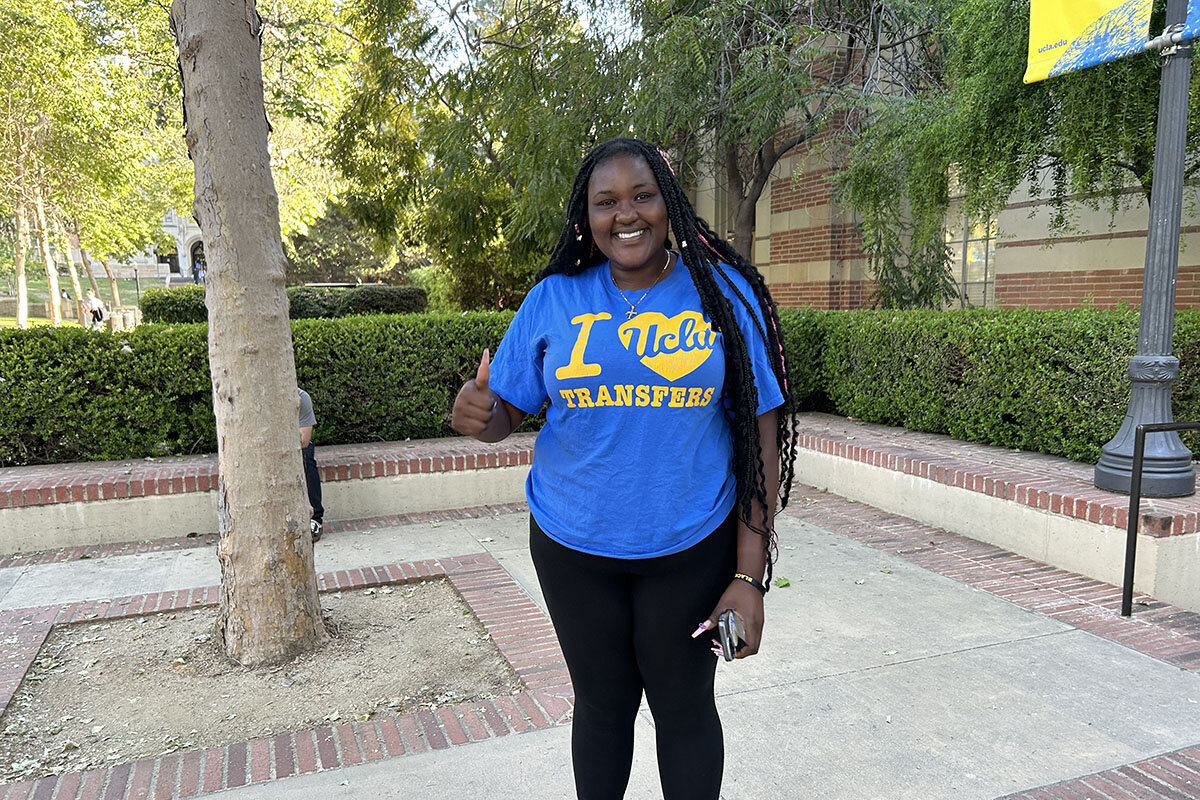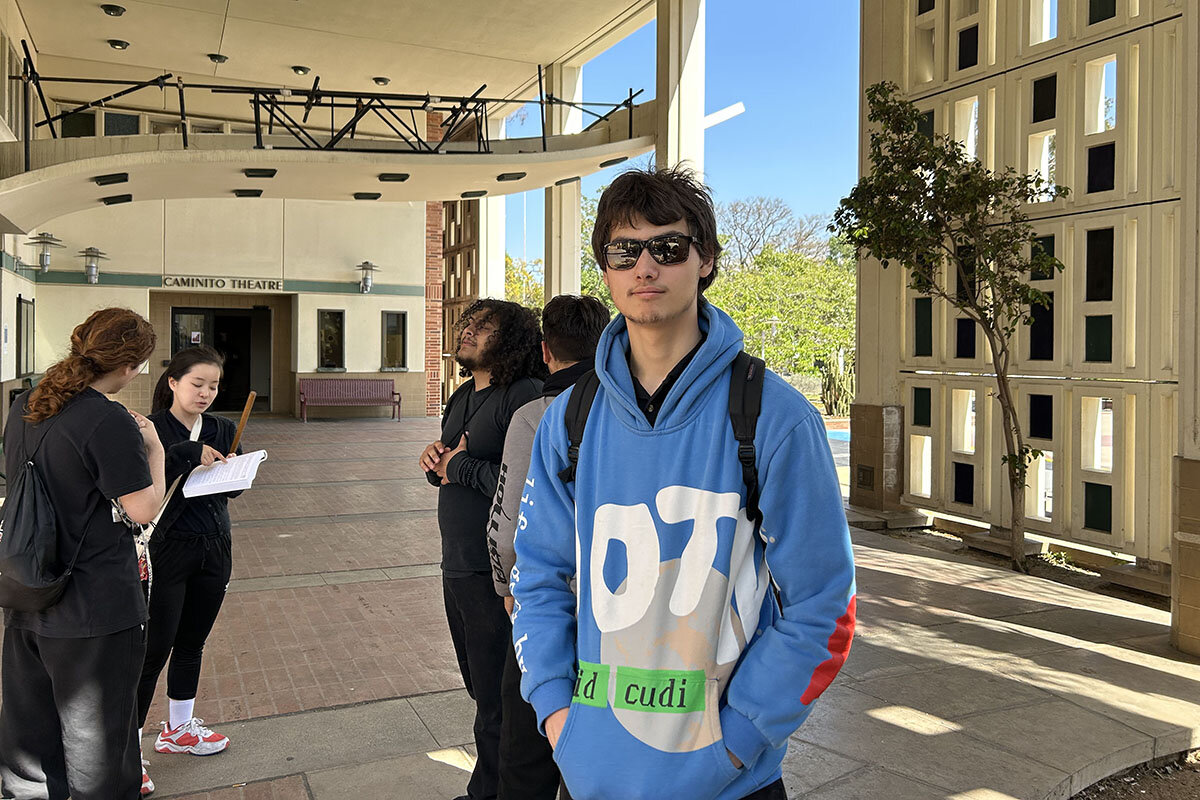Guaranteed transfers for community college? California may chart a path.
Loading...
| Los Angeles
When the University of California system proposed a universal guaranteed admissions program for community college students in March, it piqued the interest of those who seek entry into one of the most selective university systems in the United States.
If California legislators approve the guaranteed transfer program, for the first time it would include all nine UC campuses – including the Los Angeles, Berkeley, and San Diego campuses. It would also create a universal set of acceptance criteria for the more than 2 million California students who attend 116 community colleges in the state annually.
Why We Wrote This
A story focused onWhat’s the best way to help community college students who want a four-year degree? In California, a proposal hopes to offer transfer students access to universities that have typically been out of reach.
Students would not be guaranteed enrollment at the newly added schools, but they would be guaranteed to get into the UC system.
“Students get excited about a simpler path, and they are looking for California leaders to work out the challenges and make it happen,” says Jessie Ryan, with The Campaign for College Opportunity.
She says that the proposal needs to make clear how financial aid can be transferred from school to school, and that housing needs to be considered for acceptance, given that many students have work or family obligations nearer their homes.
Scott Colonese, a first-year student at Los Angeles City College, has his eye on UCLA, a school he says offers a variety of subjects he can pursue.
“I think having a guaranteed path to get in is fantastic,” he says.
When the University of California system proposed a universal guaranteed admissions program for community college students in March, it piqued the interest of those who seek entry into one of the most selective university systems in the country.
Scott Colonese is one of them. Multiple times a week he drives from his one bedroom apartment in Hollywood to Los Angeles City College with a 40-pound cello and hard case strapped to his right shoulder. A first-year student from Stockton, California, he made a pit stop at LACC before moving onto the place where he envisions himself.
“I want to go to UCLA,” the 18-year-old beams confidently, after attending classes on the LACC campus. “It’s the variety. I’d like to go into modeling. I want to go into some film stuff. I want to do music and just do art in general. So UCLA is a great place to be able to explore opportunities like that.”
Why We Wrote This
A story focused onWhat’s the best way to help community college students who want a four-year degree? In California, a proposal hopes to offer transfer students access to universities that have typically been out of reach.
The University of California, Los Angeles, and several other southern California branches of the university system rejected him straight out of high school, even though he had a 3.9 GPA, he says. “I was unlucky,” he adds, “but I think having a guaranteed path to get in is fantastic.”
If California legislators approve the guaranteed transfer program, for the first time it would include all nine campuses – adding three of the most selective schools: UCLA, the University of California, Berkeley, and the University of California, San Diego. It would also create a universal set of acceptance criteria for the more than 2 million California students who attend 116 community colleges in the state annually.
“Students get excited about a simpler path, and they are looking for California leaders to work out the challenges and make it happen,” says Jessie Ryan, executive vice president for The Campaign for College Opportunity, a California nonprofit that advocates for access to affordable college for low-income and first generation students, and students of color.
For the first time, the most selective UC schools would be in the mix for community college transfer students. However, there’s no guarantee that someone will get into Berkeley or UCLA. What California would guarantee is admission to the UC system at either the Merced, Riverside, and Santa Cruz campuses.
A combined 70% of California community college students transfer to the UC system or the California State University system, with most going to CSU. Many students go straight from high school to community colleges, hoping that it will offer a path for them to get into the UC system, which has a more stringent set of admissions requirements.
Selective schools in the UC system have come under fire for not accepting more transfer students. The proposed transfer admissions initiative came after Gov. Gavin Newsom threatened to cut $20 million in state funding from UCLA if a transfer guarantee program was not created. However, the nonpartisan Legislative Analyst’s Office disagrees with the approach, noting that UCLA enrolls more transfer students “than any other UC campus.”
“The University of California is grateful to Governor Newsom for getting us started on a path to developing a more streamlined and easily understandable set of requirements to achieve guaranteed admission to the system,” Ryan King, a UC spokesperson, wrote in a statement to the Monitor. He notes that the idea is still at the proposal stage, but that “achieving a more accessible transfer pathway” is a “shared goal.”
The proposal would also create a uniform set of admittance criteria for the UC system for community college transfers. Overall, this would offer a clear path for students, including classes required and the GPA needed for admission – instead of students taking classes that they don’t need and trying specifically to meet individual requirements for each school.
But so far those specifics have not been released, Ms. Ryan says.
She says that the UC proposal also needs to make clear that whatever financial aid California students receive for one school in the system should be transferable to one of the other schools. And housing needs to be taken into consideration for acceptance, because many students have work or family obligations that keep them closer to UC schools near where they live, such as a school like UCLA.
Her organization has been advocating for the UC system to adopt the associate degree for transfer program, which the CSU system has. In fact, there is currently a state bill, AB-1749, which The Campaign for College Opportunity supports, that would include associate degree transfers for the UC system.
These types of steps are important, she says, because California needs to consider limiting brain drain. Already, attractive programs exist for students for guaranteed admission to 39 historically Black colleges and universities.
“We should be giving them that clear roadmap to transfer day one when they enter a community college,” she says.
George Limb wants to go to UCLA to be an actor. He says he’s been to Cal Poly Humboldt and Cal Maritime, but transferred to LACC with some general education courses that he thinks should make transferring into UCLA easier.
“The Cal States are easier. The UCs are hard,” he says. He’s doing what he can to stand out while still at a community college. He has a 3.3 GPA, but is working to increase that. And he has joined an acting troupe that he practices with at community college.
“If you put the work in you should be able to get into a good school,” he says.
But not everyone is interested in getting into a selective UC school. Erwin Meija has his mind on Cal State.
“I’ve spoken to counselors and they told me that UCs are more focused on research, and me personally, that’s not what I’m going to do,” says Mr. Meija, who started at LACC in fall 2022. He wants to be an accountant to help others, not to add to scholarship in the discipline.
He is interested in going to Cal State LA because it’s closer to his home in Culver City and it will be more affordable. And he feels like it will be easier to get into, since his GPA isn’t north of a 3.0.
“I’m just more concentrated on seeing if Cal States accepts me,” he says.
Guaranteed admissions could address declining enrollment across California’s institutions of higher ed, including community college transfer applicants. According to UC Institutional Research and Academic Planning, the total number of community college transfers – domestic and international – dropped university-wide from 38,879 in 2021 to 31,645 this year. One bright spot: As of 2021, nearly a third of UC undergraduates transfer from community college, and 88% of all transfer students graduate.
Transferring paid off for Yaseen Elhalafawy. He transferred to UCLA from Saddleback College, a community college in Mission Viejo, California, at the start of the current school year.
“It’s probably harder for freshmen to get in right out of high school, but the thing with community college is, if you’re doing it right it’s very easy to get it right. You just have to put in the work, but it’s not complicated,” Mr. Elhalafawy adds, standing in the hallway of Kerckhoff Hall, a Gothic structure on the UCLA campus that evokes Hogwarts. The student newspaper and student government office is here, and transfer students have their own space where they congregate.
Mr. Elhalawafy says GPA matters, but so do things like extracurricular activities.
“I played tennis. I was pro for a while,” he says. The pandemic shut that down, and he went back home to Orange County to work with a community organization teaching kids the fundamentals of the sport. Because he had a high GPA and an interesting story, he aimed for the stars in terms of the schools that he applied to, even the Ivy League.
“This is a good institution,” he says, smiling. “It’s the No. 1 public institution in the country.”
He is in an honors program and wants to work in local government and possibly be a city council member one day. Everything is possible, he says.
“I know this is a dream school for a lot of people,” he says. “There’s probably a lot of people where [UCLA] just had to make a decision and say no. I know people who got into Berkeley that didn’t get into here, so there’s always more opportunities to transfer in from another school.”










